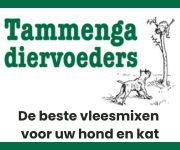*Dorothea* schreef:
Nou 1% lijkt mij nog minder dan bij gecastreerde teven, ik denk dat dat niet klopt.
Er staat:
Voor de eerste loopsheid: 0,005%.
Na 1 of meer loopsheden: 0,26%
Uit een andere rangschikking:
Jonger dan 29 maanden: 0,06%
Ouder dan 30 maanden: 0,40%
Complete teven: 1%
In het Engelse artikel staat:
Mammary tumors are by far the most common tumors in intact female dogs, constituting some 53% of all
malignant tumors in female dogs in a study of dogs in Norway15 where spaying is much less common than in
the USA.
50-60% of mammary tumors are malignant, for which there is a significant risk of metastasis16. Mammary
tumors in dogs have been found to have estrogen receptors17, and the published research18 shows that the
relative risk (odds ratio) that a female will develop mammary cancer compared to the risk in intact females is
dependent on how many estrus cycles she experiences:
# of estrus cycles before spay Odds Ratio
None 0.005
1 0.08
2 or more 0.26
Intact 1.00
The same data when categorized differently showed that the relative risk (odds ratio) that females will
develop mammary cancer compared to the risk in intact females indicated that:
Age at Spaying Odds Ratio
29 months 0.06
30 months 0.40 (not statistically significant at the P<0.05 level)
Intact 1.00
Please note that these are RELATIVE risks. This study has been referenced elsewhere many times but the
results have often been misrepresented as absolute risks.
A similar reduction in breast cancer risk was found for women under the age of 40 who lost their estrogen
production due to “artificial menopause”19 and breast cancer in humans is known to be estrogen activated.
Mammary cancer was found to be the 10th most common cause of years of lost life in Golden Retrievers,
even though 86% of female GRs were spayed, at a median age of 3.4 yrs10. Considering that the female
subset accounts for almost all mammary cancer cases, it probably would rank at about the 5th most common
cause of years of lost life in female GRs. It would rank higher still if more female GRs had been kept intact
up to 30 months of age.
Boxers, cocker spaniels, English Springer spaniels, and dachshunds are breeds at high risk of mammary
tumors15. A population of mostly intact female Boxers was found to have a 40% chance of developing
mammary cancer between the ages of 6-12 years of age15. There are some indications that purebred dogs
may be at higher risk than mixed breed dogs, and purebred dogs with high inbreeding coefficients may be at
higher risk than those with low inbreeding coefficients20. More investigation is required to determine if these
are significant.
In summary, spaying female dogs significantly reduces the risk of mammary cancer (a common cancer),
and the fewer estrus cycles experienced at least up to 30 months of age, the lower the risk will be.







